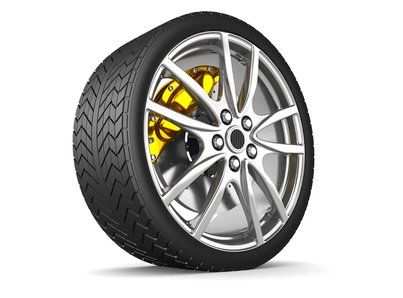TYRES & EXHAUST
Tyre Service
Tyre Balance
To run true and keep the tread in constant contact with the road, the wheel and tyre have to be correctly balanced. If the vehicle was to be raised on a jack and the wheel spun by hand, an unbalanced wheel would always stop at the same point - with the heavier imbalance being of course at the bottom of the wheel.
On the road, wheel imbalance can actually lift the tyre from contact with the road creating vibration through the steering wheel and causing dangerous problems with steering and braking. Damage to the suspension, wheel bearings and steering components is unavoidable if the imbalance is left unattended.
VALVES
The tyre valve is the most neglected and overlooked component within the wheel and tyre assembly, yet an efficient valve is crucial to the safe operation of the tyre.
Wear on the valve seal, damaged screw threads, dirt and grit in the valve itself can all lead to a dangerous failure of the
tyre at speed.
Even a poorly sealed valve can cause fairly constant under inflation of the tyre which will reduce the life of
your tyre by 25%.
As it is impossible, to replace the valve without removing the tyre casing from the wheel.
Factors affecting tyre choice
Given that your tyres are the ONLY contact that you and your car has with the road - their importance to your safety and well being cannot be understated. Choosing the right tyre for your requirements is therefore a serious process and not one that should be made without careful consideration of the options available. Often tyres have to be replaced long before their specified life has been reached principally because of rapid or uneven tread wear. The most common causes of avoidable tread wear are:
• Under-Inflating - Causing rapid wear along the
edges of the tread.
• Over-Inflating - Causing rapid wear along the centre
of the tread.
• Faulty brakes or shock absorbers - Can cause flat bald spots around the tread of the tyre.
Tyre Damage Limitation
Cuts, breaks and abrasions to the tyre casing can penetrate deep into the inner fabric of the tyre and can be extremely dangerous, capable of causing high speed blow-outs. However, penetration of the tread by a nail or shard of glass or metal can often be safely repaired.

Exhaust Service
Although there are no moving parts in an exhaust system, its function and placement on the vehicle means it is one of the hardest worked components on the car.
Effects of rust and corrosion by toxic wastes combine to attack the metals of the system leading to noisy and dangerous failures.
A 'blown', noisy exhaust is illegal and can lead to a fine. In addition, the leakage of toxic fumes from a failed exhaust into the car can lead to headaches, sickness and drowsiness, with the possibility of catastrophic results.
Here are the key components of a typical exhaust system:
Exhaust continued
Tail Pipe
The tail pipe allows free exit of the exhaust gases into the atmosphere.
Catalytic Converter
Modern exhaust systems are designed to remove most of the harmful pollutants from the exhaust gases before release into the atmosphere. This is done by a component fitted into the exhaust system called a Catalytic Converter, or CAT. A specially lined box filters and converts the hot polluted exhaust gases into a much more environmentally friendly mixture. This mixture then passes along the exhaust pipe to the silencer or silencers before being expelled through the tail pipe and into the atmosphere.
Exhaust continued
Silencer Box
There may be more than one silencer box fitted to your car. The silencer is specially designed to absorb sound waves created by the engine and reduce this noise to a legally and environmentally acceptable level.
Exhaust Manifold Connection
The front piece of the exhaust pipe has a special coupling designed to be attached directly to the exhaust manifold which in turn is part of the engine. To absorb the varying stresses of the engine's vibration, the front piece of the exhaust pipe may contain a flexible section to avoid damage to both the exhaust system and the engine.
Catalytic Converter
Modern exhaust systems are designed to remove most of the harmful pollutants from the exhaust gases before release into the atmosphere. This is done by a component fitted into the exhaust system called a Catalytic Converter, or CAT. A specially lined box filters and converts the hot polluted exhaust gases into a much more environmentally friendly mixture. This mixture then passes along the exhaust pipe to the silencer or silencers before being expelled through the tail pipe and into the atmosphere.

